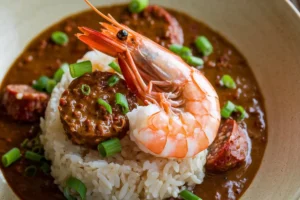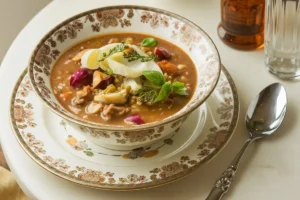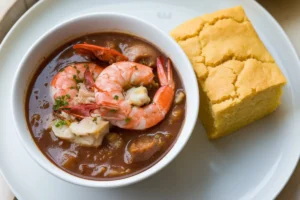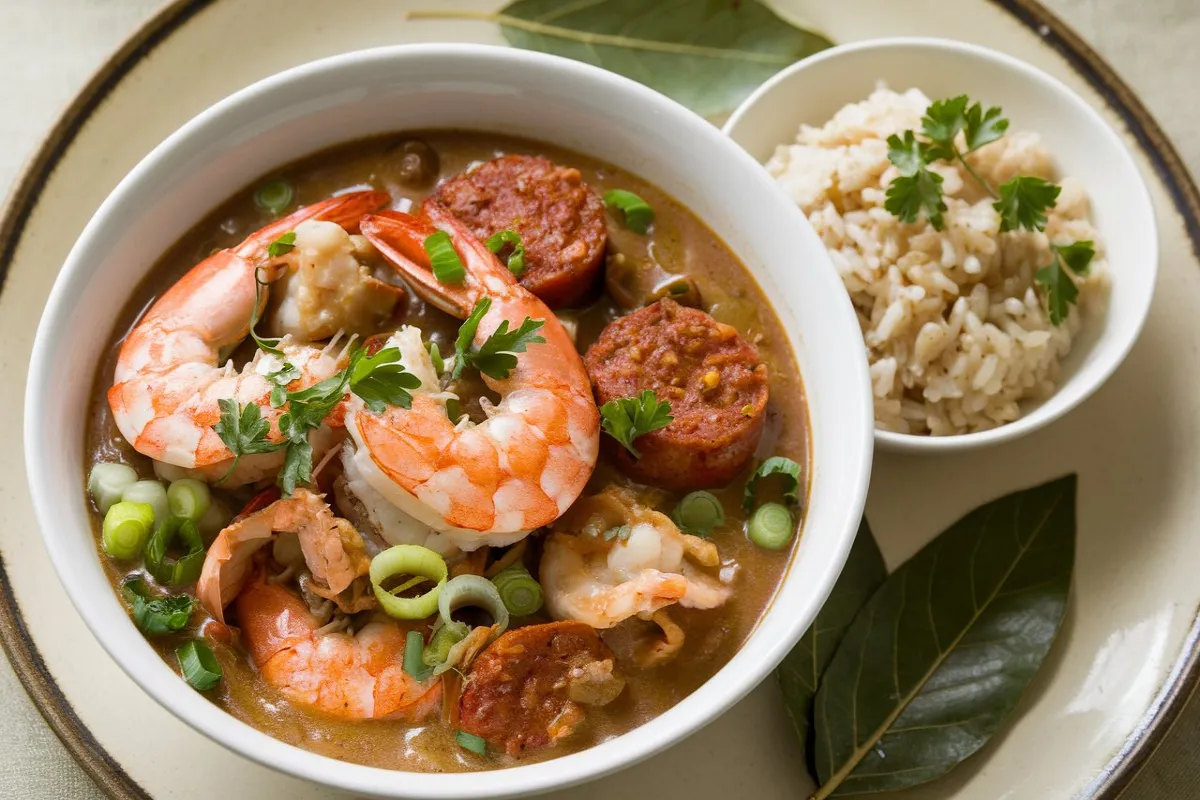The Ultimate Guide to Gumbo: Authentic Recipes, Tips, and Variations
Introduction to Gumbo
Gumbo is a quintessential dish from Louisiana, rich in history and tradition. It is a symbol of Creole and Cajun cooking, known for its deep flavors and hearty ingredients. Rooted in a blend of African, French, Spanish, and Native American cuisines, gumbo is more than just a stew—it’s a celebration of cultural diversity. Typically made with a flavorful roux, a mix of meats and/or seafood, and the “holy trinity” of vegetables (bell pepper, onions, and celery), gumbo is a must-try for any food lover.
In this guide, we’ll explore everything you need to know about making gumbo, from its types to the essential ingredients, cooking methods, and variations, so you can master this iconic dish. Whether you’re a beginner or a seasoned cook, by the end of this article, you’ll be able to make your own authentic gumbo at home.
Types of Gumbo
While there are many variations of gumbo, the two most popular styles are Creole and Cajun:
- Creole Gumbo: This version is typically made with seafood, tomatoes, and a rich broth. Creole gumbo is often lighter than Cajun gumbo, thanks to the inclusion of tomatoes, which add a bit of brightness to the dish. Influenced by French and Spanish cuisines, Creole gumbo often reflects the urban flavor of New Orleans.
- Cajun Gumbo: Cajun gumbo, on the other hand, is darker and heartier. Made with a dark roux, smoked sausages like andouille, and usually chicken, Cajun gumbo embodies the rustic, country cooking of southern Louisiana. It omits tomatoes and instead focuses on deep, smoky flavors.
- Seafood Gumbo: This variety highlights the bounty of the Gulf of Mexico and often includes shrimp, crab, and oysters. Seafood gumbo can be either Creole or Cajun in style, but it always places an emphasis on fresh seafood.
Understanding the differences between these types of gumbo will help you decide which version best suits your taste.
For an in-depth look at how this iconic dish developed, check out the history of gumbo.
Key Ingredients in Gumbo
The key to a great gumbo lies in the quality of the ingredients. Here are the essentials:
- Roux: The roux is a cornerstone of gumbo. It’s made by slowly cooking flour and fat together until it reaches the desired color—ranging from light blonde to a dark, chocolate-like hue. The darker the roux, the more depth it brings to the dish.
- Holy Trinity: This term refers to the trio of vegetables—bell peppers, onions, and celery—that serve as the base for nearly all gumbo recipes. Their sweet and aromatic flavors create a perfect foundation.
- Proteins: The most common proteins used in gumbo are chicken, sausage, and seafood. Some versions may even include game meats like duck.
- Spices and Seasonings: Essential spices include paprika, cayenne pepper, thyme, and bay leaves. For added flavor, some recipes call for filé powder, a seasoning made from ground sassafras leaves. This is added at the end of cooking to thicken the gumbo and enhance its flavor. For more information on the role of filé powder, visit this resource on what is filé powder in gumbo.
Step-by-Step Guide: Classic Chicken and Sausage Gumbo Recipe

Let’s walk through a traditional chicken and sausage gumbo recipe. This hearty dish is perfect for colder months and can easily be adjusted based on your preferences.
- Prepare Ingredients
- Start by chopping your bell pepper, onion, and celery. Set aside.
- Slice andouille sausage into thin rounds. Cube your chicken thighs.
- Make the Roux
- In a heavy-bottomed pot or Dutch oven, heat oil over medium heat. Gradually whisk in flour, stirring constantly. Cook until the roux reaches a deep brown color (about 20-30 minutes). Be patient—burning the roux means starting over.
- Add the Holy Trinity
- Once the roux is ready, stir in the vegetables. Sauté them until softened and aromatic.
- Combine Ingredients
- Add the sliced sausage, chicken, and spices. Stir to coat everything in the roux. Then pour in chicken broth and bring to a boil. Reduce heat and simmer for at least an hour, allowing the flavors to meld.
- Finish and Serve
- Adjust seasoning with salt, pepper, and hot sauce to taste. Serve the gumbo over a bed of white rice, and garnish with chopped green onions or parsley.
Seafood Gumbo Variation
If you prefer seafood over meat, consider trying a classic seafood gumbo. Here’s how you can adapt the recipe:
- Choose Your Seafood: Popular options include shrimp, crab, and oysters. You can also add crawfish if available.
- Cooking Seafood in Gumbo: Seafood should be added towards the end of cooking to prevent it from overcooking. Shrimp, for example, only needs about 5 minutes in the hot broth.
- Regional Influences: In coastal Louisiana, seafood gumbo is a reflection of the local ingredients. While Cajun gumbo typically leans on darker flavors, seafood gumbo often strikes a balance with a lighter broth and a fresher taste.
For guidance on how to select the best sausage for gumbo, visit the best sausages for gumbo.
Vegetarian and Vegan Gumbo
Don’t worry if you’re avoiding meat—gumbo can still be delicious without animal products. Vegetarian gumbo uses plant-based ingredients while retaining the dish’s bold flavors.
- Proteins and Substitutes: Replace the meat with beans, mushrooms, okra, and vegan sausage. These hearty alternatives still provide the richness and substance that gumbo is known for.
- Building Flavor: The secret to a great vegetarian gumbo lies in the roux and spices. A rich, dark roux gives the dish its signature depth, while herbs and seasonings add complexity.
- Serving Suggestions: As with traditional gumbo, vegetarian versions are best served over white rice or alongside cornbread.
Cooking Tips and Tricks

Mastering gumbo takes practice, but these tips will ensure you’re on the right track:
- Achieving the Right Consistency: A good gumbo should be thick but not overly so. You can thicken it with roux, okra, or filé powder, depending on your preference.
- Avoiding Common Mistakes: Stir your roux constantly to avoid burning it. If your gumbo lacks flavor, don’t be afraid to add more seasoning or simmer it longer.
- Tasting as You Go: One of the keys to a great gumbo is tasting and adjusting the seasoning throughout the cooking process.
How to Serve Gumbo
Serving gumbo properly is just as important as cooking it:
- Traditional Accompaniments: Most often, gumbo is served over white rice. However, it’s also delicious with a side of crusty French bread or cornbread.
- Garnishes: Top your gumbo with chopped green onions or parsley, and offer hot sauce on the side for those who want an extra kick.
FAQs about Gumbo
Here are some frequently asked questions about making and serving gumbo:
- What’s the difference between gumbo and jambalaya?
- While both are classic Louisiana dishes, gumbo is a stew that’s served over rice, while jambalaya is a one-pot rice dish cooked with the ingredients.
- Can gumbo be made gluten-free?
- Yes! Simply use a gluten-free flour when making your roux and ensure all other ingredients are gluten-free.
- How long does gumbo last in the fridge?
- Gumbo can be refrigerated for up to three days and often tastes better the day after cooking.
- Can you freeze gumbo?
- Yes, gumbo freezes well. Store it in airtight containers for up to three months.
- What is the best sausage to use in gumbo?
- Andouille sausage is traditional, but you can also use smoked sausage or even a vegan alternative for a meatless version.
Health Considerations
Though gumbo is a flavorful dish, it can be high in calories, fat, and sodium. Here are some tips for making it healthier:
- Lowering Calories: Use lean proteins like chicken breast or turkey sausage.
- Reducing Sodium: Opt for low-sodium broth and be mindful of how much salt you add during cooking.
- Adding Vegetables: Increase the vegetable content by adding
more okra, tomatoes, bell peppers, and greens to your gumbo. This will not only enhance the flavor but also boost the nutritional value of the dish. Vegetables are low in calories and packed with essential vitamins and minerals, making them a healthy addition to your gumbo.
If you’re looking to make your gumbo even lighter, consider cutting back on the amount of roux used. You can still achieve a deliciously thick texture by incorporating okra or filé powder as alternative thickeners. These options offer a healthier way to get the consistency you desire without adding extra fat.

Conclusion
Whether you prefer the rich, smoky flavors of Cajun gumbo or the lighter, tomato-infused taste of Creole gumbo, there’s no denying that gumbo is a dish full of tradition, flavor, and versatility. With a good roux, quality ingredients, and the right techniques, you can bring a taste of Louisiana to your own kitchen.
From the classic chicken and sausage gumbo to a seafood-packed version or even a vegetarian alternative, gumbo offers something for everyone. By following the steps outlined in this guide, you’ll be well on your way to making a hearty, flavorful pot of gumbo that your family and friends will love. Don’t forget to serve it with a side of rice, cornbread, or French bread for a complete and satisfying meal.

